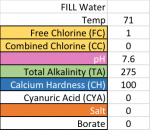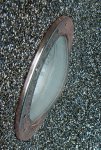- Jul 27, 2017
- 82
- Pool Size
- 28000
- Surface
- Plaster
- Chlorine
- Salt Water Generator
- SWG Type
- Pentair Intellichlor IC-40
I have essentially the same question, and my OCD makes me want to increase my hardness.
I’m coming off a SLAM - I wouldn’t have done this out of the gates (just opened the pool on 5/2) but my Pool Company opened the pool for us and immediately threw shock into the pool, so I figured I would continue the process and take advantage of the high FC.
My test this morning had results of:
FC = 9.5
CC = .5
CH = 280
TA = 70
CYA = 55
ph = 7.6
Salt = 3200
Borate = 80
I feel compelled to raise my CH to 350.
The other minor issue I’m having is that the metal around my lights has a slight pink “dusting” on it. It seems to rub off with my hands - but not sure what that is. Is that the start of corrosion, and if so, I’m thinking low CH might be a contributing factor.
I’m coming off a SLAM - I wouldn’t have done this out of the gates (just opened the pool on 5/2) but my Pool Company opened the pool for us and immediately threw shock into the pool, so I figured I would continue the process and take advantage of the high FC.
My test this morning had results of:
FC = 9.5
CC = .5
CH = 280
TA = 70
CYA = 55
ph = 7.6
Salt = 3200
Borate = 80
I feel compelled to raise my CH to 350.
The other minor issue I’m having is that the metal around my lights has a slight pink “dusting” on it. It seems to rub off with my hands - but not sure what that is. Is that the start of corrosion, and if so, I’m thinking low CH might be a contributing factor.



